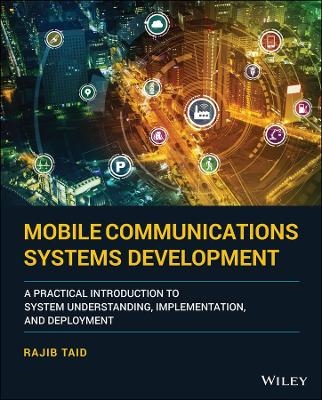
Mobile Communications Systems Development
John Wiley & Sons Inc (Verlag)
978-1-119-77868-4 (ISBN)
Mobile Communications Systems Development: A Practical Introduction for System Understanding, Implementation, and Deployment is a comprehensive “how to” manual for mobile communications system design, deployment, and support. Providing a detailed overview of end-to-end system development, the book encompasses operation, maintenance, and troubleshooting of currently available mobile communication technologies and systems. Readers are introduced to different network architectures, standardization, protocols, and functions including 2G, 3G, 4G, and 5G networks, and the 3GPP standard.
In-depth chapters cover the entire protocol stack from the Physical (PHY) to the Application layer, discuss theoretical and practical considerations, and describe software implementation based on the 3GPP standardized technical specifications. The book includes figures, tables, and sample computer code to help readers thoroughly comprehend the functions and underlying concepts of a mobile communications network. Each chapter includes an introduction to the topic and a chapter summary. A full list of references, and a set of exercises are also provided at the end of the book to test comprehension and strengthen understanding of the material. Written by a respected professional with more than 20 years’ experience in the field, this highly practical guide:
Provides detailed introductory information on GSM, GPRS, UMTS, and LTE mobile communications systems and networks
Describes the various aspects and areas of the LTE system air interface and its protocol layers
Covers troubleshooting and resolution of mobile communications systems and networks issues
Discusses the software and hardware platforms used for the development of mobile communications systems network elements
Includes 5G use cases, enablers, and architectures that cover the 5G NR (New Radio) and 5G Core Network
Mobile Communications Systems Development is perfect for graduate and postdoctoral students studying mobile communications and telecom design, electronic engineering undergraduate students in their final year, research and development engineers, and network operation and maintenance personnel.
Rajib Taid is currently Deputy General Manager (Information Technology) for BCPL, India. He has over 20 years of experience working with and in government agencies and private corporations. His competencies range from mobile communications software research and development to managing multiple technology domains and platforms.
About the Author xiv
Preface xv
Acknowledgments xviii
List of Abbreviations xix
1 Introduction 1
Part I Network Architectures, Standardization, Protocols, and Functions 3
2 Network Architectures, Standardizations Process 5
2.1 Network Elements and Basic Networks Architectures 5
2.1.1 GSM (2G) Network Architecture 6
2.1.2 General Packet Radio Service (GPRS-2.5G) Network Architecture 7
2.1.3 Universal Mobile Telecommunications System (3G) Network Architecture 7
2.1.4 LTE (4G) Network Architecture 8
2.1.5 GSM, UMTS, LTE, and 5G Network Elements: A Comparison 9
2.1.6 Circuit Switched (CS) vs Packet Switched (PS) 9
2.2 Mobile Communication Network Domains 10
2.2.1 AN Domain 10
2.2.2 Core Network (CN) Domain 11
2.2.3 Network Domains and Its Elements 11
2.2.4 Example: End-to-End Mobile Network Information Flow 12
2.2.5 Example: GSM MO Call 13
2.3 Mobile Communications Systems Evolutions 14
2.3.1 Evolutions of Air Interface 14
2.3.2 Evolutions of 3GPP Networks Architectures 16
2.4 Mobile Communications Network System Engineering 19
2.4.1 Mobility Management 19
2.4.2 Air Interface Management 20
2.4.3 Subscribers and Services Management 20
2.4.4 Security Management 20
2.4.5 Network Maintenance 20
2.5 Standardizations of Mobile Communications Networks 21
2.5.1 3rd Generation Partnership Project (3GPP) 21
2.5.2 3GPP Working Groups 21
2.5.3 3GPP Technical Specification and Technical Report 22
2.5.4 Stages of a 3GPP Technical Specification 22
2.5.5 Release Number of 3GPP Technical Specification 22
2.5.6 3GPP Technical Specification Numbering Nomenclature 23
2.5.7 Vocabulary of 3GPP Specifications 24
2.5.8 Examples in a 3GPP Technical Specification 24
2.5.9 Standardization of Technical Specifications by 3GPP 24
2.5.10 Scope of 3GPP Technical Specification (TS) 24
2.5.11 3GPP TS for General Description of a Protocol Layer 25
2.5.12 3GPP TS Drafting Rules: Deriving Requirements 25
2.5.13 Download 3GPP Technical Specifications 25
2.5.14 3GPP Change Requests 26
2.5.15 Learnings from 3GPP Meetings TDocs 26
2.6 3GPP Releases and Its Features 26
Chapter Summary 27
3 Protocols, Interfaces, and Architectures 29
3.1 Protocol Interface and Its Stack 29
3.1.1 Physical Interface 30
3.1.2 Logical Interface 30
3.1.3 Logical Interfaces’ Names and Their Protocol Stack 33
3.1.4 Examples of Logical Interface and Its Protocol Layers 35
3.2 Classifications of Protocol Layers 36
3.2.1 Control Plane or Signaling Protocols 36
3.2.2 User Plane Protocols 38
3.3 Grouping of UMTS, LTE, and 5G Air Interface Protocol Layers 39
3.3.1 Access Stratum (AS): UMTS UE – UTRAN; LTE UE – E-UTRAN;5G UE - NG-RAN 39
3.3.2 Non-Access Stratum: UMTS UE – CN, LTE UE – EPC; 5G UE-Core 41
3.4 Initialization of a Logical Interface 42
3.5 Protocol Layer Termination 43
3.6 Protocol Sublayers 43
3.7 Protocol Conversion 44
3.8 Working Model of a 3GPP Protocol Layer: Services and Functions 45
3.9 General Protocol Model Between RAN and CN (UMTS, LTE, 5G) 46
3.10 Multiple Transport Networks, Protocols, and Physical Layer Interfaces 47
3.11 How to Identify and Understand Protocol Architectures 49
3.11.1 Identifying a Logical Interface, Protocol Stack, and Its Layers 49
3.11.2 Identification of Technical Requirements Using Interface Name 51
3.12 Protocol Layer Procedures over CN Interfaces 51
3.12.1 Similar Functions and Procedures over the CN Interfaces 52
3.12.2 Specific Functions and Procedures over the CN Interfaces 53
Chapter Summary 54
4 Encoding and Decoding of Messages 55
4.1 Description and Encoding/Decoding of Air Interface Messages 55
4.1.1 Encoding/Decoding: Air Interface Layer 3 Messages 56
4.1.2 Encoding/Decoding: LTE and 5G NR Layer 2: RLC Protocol 60
4.1.3 Encoding/Decoding: LTE and 5G NR Layer 2: MAC Protocol 60
4.1.4 CSN.1 Encoding/Decoding: GPRS Layer 2 Protocol (RLC/MAC) 60
4.1.5 ASN.1 Encoding/Decoding: UMTS, LTE, and 5G NR Layer 3 Protocol 61
4.1.6 Direct/Indirect Encoding Method 62
4.1.7 Segmented Messages over the Air Interface 63
4.1.8 Piggybacking a Signaling Message 63
4.2 Encoding/Decoding of Signaling Messages: RAN and CN 64
Chapter Summary 65
5 Network Elements: Identities and Its Addressing 67
5.1 Network Elements and Their Identities 67
5.2 Permanent Identities 68
5.3 Temporary Identities Assigned by CN 69
5.3.1 GSM System Temporary Identities 69
5.3.2 GPRS System Temporary Identities 69
5.3.3 LTE/EPS System Temporary Identities 70
5.4 Temporary Identities Assigned by RAN: RNTI 72
5.5 Usages of Network Identities 73
5.6 Native and Mapped Network Identities 73
5.7 LTE UE Application Protocol Identity 75
Chapter Summary 76
6 Interworking and Interoperations of Mobile Communications Networks 77
6.1 Requirements and Types of Interworking 77
6.2 Interworking Through Enhanced Network Elements 78
6.2.1 Interworking for Voice Call Through IMS: VoLTE 79
6.2.1.1 IP Multimedia Subsystem (IMS) 80
6.2.1.2 UE Registration and Authentication 81
6.2.2 Interworking for VoLTE Call Through LTE/EPS: SRVCC 83
6.2.3 Interworking for Voice Call Through LTE/EPS: CSFB 85
6.3 Interworking Through Legacy Network Elements 88
6.4 Interworking Between LTE/EPS and 5G Systems 89
6.5 Interoperations of Networks: LTE/EPS Roaming 90
6.5.1 Roaming Through Interoperations of Enhanced Networks Elements 90
6.5.2 Roaming Through Interoperations of Legacy Networks Elements 92
6.6 UE Mode of Operation 92
6.7 Function of E-UTRAN in a VoLTE Call 95
Chapter Summary 95
7 Load Balancing and Network Sharing 97
7.1 Core Network Elements Load Balancing 97
7.1.1 Identification of NAS Node: NRI and Its Source 99
7.1.2 NAS Node Selection Function 99
7.2 Network Sharing 102
7.2.1 GSM/GPRS/LTE RAN Sharing Through MOCN Feature 103
7.2.2 5G NG‐RAN Sharing Through MOCN Feature (Release 16) 109
Chapter Summary 110
8 Packets Encapsulations and Their Routing 111
8.1 User Data Packets Encapsulations 111
8.1.1 Packets Encapsulations at the CN and RAN 112
8.1.1.1 GPRS Tunneling Protocol ( GTP) 112
8.1.1.2 GTP Functions 112
8.1.1.3 GTP User Plane PDU: G-PDU 113
8.1.1.4 GTP Control Plane PDU 114
8.1.1.5 Example: GTP and Packet Encapsulations at LTE EPC 115
8.1.2 Packet Encapsulations over Air Interface 115
8.2 IP Packet Routing in Mobile Communications Networks 116
8.3 IP Header Compression and Decompression 117
Chapter Summary 119
9 Security Features in Mobile Communications Networks 121
9.1 A Brief on the Security Architecture: Features and Mechanisms 121
9.2 Security Features and Its Mechanisms 123
9.3 GSM Security Procedures 126
9.4 UMTS, LTE, and 5G: AS and NAS Layer Security Procedures 127
9.5 Security Contexts 130
9.6 Security Interworking 130
Chapter Summary 132
Part II Operations and Maintenances 133
10 Alarms and Faults Managements 135
10.1 Network Elements Alarm and Its Classifications 135
10.2 Sources of Abnormal Events and Alarms 136
10.3 Identifying Sources of Alarms from 3GPP TSs 136
10.3.1 Abnormal Conditions 136
10.3.2 Protocol Layer Error Handling 137
10.3.3 Abnormal Conditions Due to Local Errors 138
10.4 Design and Implementation of an Alarm Management System 138
10.4.1 Design and Components of an Alarm 139
10.4.2 Alarm Application Programming Interfaces (APIs) 139
10.4.3 Alarm Database 139
10.5 Alarm Due to Protocol Error 140
10.5.1 Sample Protocol Error Alarm Description 142
10.6 Alarm Due to Abnormal Conditions 142
10.6.1 Normal Scenario 143
10.6.2 Abnormal Scenario 143
10.6.3 Sample Alarm Description 144
10.6.4 Sample Alarm Generation 145
10.6.5 Sample Protocol Error Alarm Generation 145
10.7 How to Troubleshoot Protocol Error Using the Alarm Data 146
Chapter Summary 146
11 Performance Measurements and Optimizations of Mobile Communications Networks 147
11.1 Counters for Performance Measurements and Optimizations 147
11.2 Performance and Optimizations Management System 149
11.3 Key Performance Indicator (KPI) 150
11.3.1 What Is a KPI? 150
11.3.2 KPI Domains 150
11.3.3 KPI for Signaling or Control Plane 152
11.3.4 KPI for User or Data Plane 153
11.3.5 KPI Categories 154
11.3.6 KPI Evaluation Steps 155
11.3.7 Troubleshooting and Improving KPI 156
11.3.8 Components of a KPI Definition 157
Chapter Summary 157
12 Troubleshooting of Mobile Communications Networks Issues 159
12.1 Air Interface-Related Issues 159
12.1.1 Drive Test, Data Collection, and Its Analysis 160
12.2 Debugging Issues with IP-Based Logical Interface 160
12.2.1 IP Protocol Analyzer 161
12.2.2 Network/Application Throughput Issue 161
12.2.3 Switch Port Mirroring 161
12.3 Conformance Testing Issues 162
12.3.1 Example: Mobile Device (MS)/User Equipment (UE) Conformance Test 163
12.3.2 Example: Location Area Update Request 163
12.4 Interoperability Testing (IOT) Issues 164
12.5 Interworking Issues 165
12.6 Importance of Log/Traces and Its Collections 166
12.7 Steps for Troubleshooting 167
Chapter Summary 170
Part III Mobile Communications Systems Development 171
13 Core Software Development Fundamentals 173
13.1 A Brief on Software Development Fundamentals 173
13.1.1 Requirements Phase 174
13.1.2 Design 174
13.1.3 Implementation 175
13.1.4 Integration and Testing 175
13.1.5 Operation and Maintenance 175
13.2 Hardware Platforms: Embedded System, Linux Versus PC 176
13.2.1 System Development Using Embedded System Board 176
13.2.2 System Development Using Multicore Hardware Platform 177
13.2.2.1 What Is a Core? 178
13.2.2.2 Network Element Development Using Multicore Platform 178
13.2.2.3 Runtime Choices of Multicore Processor 178
13.2.2.4 Software Programming Model for Multicore Processor 179
13.3 Selecting Software Platforms and Features 179
13.3.1 Selecting Available Data/Logical Structures 180
13.3.1.1 Advanced Data Structures 180
13.3.1.2 How Data Structure Affects the Application’s Performance 180
13.3.2 Selecting an Operating System Services/Facilities 181
13.3.2.1 Advance Features of Operating System: IPC 181
13.4 Software Simulators for a Mobile Communications Network 184
13.5 Software Root Causes and Their Debugging 185
13.5.1 Incorrect Usages of Software Library System Calls/APIs 185
13.5.2 Incorrect Usages of System Resources 185
13.5.3 Bad Software Programming Practices 185
13.6 Static Code Analysis of Software 186
13.7 Software Architecture and Software Organization 186
13.8 System and Software Requirements Analysis 188
13.9 Software Quality: Reliability, Scalability, and Availability 188
13.9.1 Reliability 188
13.9.2 Scalability 188
13.9.3 Availability 188
Chapter Summary 189
14 Protocols, Protocol Stack Developments, and Testing 191
14.1 Components of a 3GPP Protocol TS 191
14.2 3GPP Protocol Layer Structured Procedure Description 193
14.3 Protocol Layer Communications 194
14.3.1 Layer-to-Layer Communication Using Service Primitives 195
14.3.2 Layer-to-Layer Communication: SAP 196
14.3.3 Peer-to-Peer Layer Communication: PDU and Service Data Unit (SDU) 197
14.3.4 Types of PDU 198
14.3.5 Formats of PDU 198
14.4 Air Interface Message Format: Signaling Layer 3 198
14.4.1 A Brief on the Air Interface Layer 3 Protocol Stack 198
14.4.2 Classification of Layer 3 Messages 199
14.4.3 Layer 3 Protocol Header: Signaling Message Format 200
14.4.4 Layer 3 Protocol Header: Protocol Discriminator 202
14.4.5 Layer 3 Protocol Header: GSM, GPRS Skip Indicator 202
14.4.6 Layer 3 Protocol Header: GSM, GPRS Transaction Identifier 204
14.4.7 Layer 3 Protocol Header: LTE/EPS Bearer Identity 204
14.4.8 Layer 3 Protocol Header: 5GSM PDU Session Identity 204
14.4.9 Constructing a Layer 3 Message 204
14.4.10 Security Protected LTE/EPS and 5G NAS Layer MM Messages 205
14.4.11 Layer 3 Protocol Layer’s Message Dump 207
14.5 Air Interface Message Format: Layer 2 207
14.6 RAN – CN Signaling Messages 208
14.6.1 Protocol Layer Elementary Procedure 208
14.6.2 Types and Classes of EPs 210
14.6.3 EPs Code 210
14.6.4 Criticality of IE 211
14.6.5 Types of Protocol Errors and Its Handling 211
14.6.6 Choices of Triggering Message 212
14.6.7 Message Type 212
14.6.8 Message Description 212
14.6.9 Example: LTE/EPS S1 Interface: S1 Setup Procedure 213
14.7 Modes Operation of a Protocol Layer 213
14.8 Example of a Protocol Primitive and PDU Definition 215
14.9 Example of a Protocol Layer Frame Header Definition 216
14.10 Examples of System Parameters 216
14.11 Examples of Protocol Information Elements and Its Identifier 217
14.12 3GPP Release Specific Changes Implementation 218
14.13 Examples of Protocol Messages Types 219
14.14 Protocol Layer Timer Handling 219
14.15 Protocol Layer Development Using State Machine 222
14.16 Protocol Layer Development Using Message Passing 224
14.17 Protocol Layer Data and its Types 225
14.18 Protocol Layer Control and Configuration 226
14.19 Protocol Context Information 227
14.20 Protocol Layer Message Padding 228
14.21 Device Driver Development 229
14.22 Guidelines for Protocol Stack/Layer Development 230
14.23 Software Profiling, Tools and Performance Improvement 231
14.24 Protocol Stack Testing and Validation 231
Chapter Summary 233
15 Deriving Requirements Specifications from a TS 235
15.1 3GPP Protocol Layer Procedures 235
15.1.1 LTE UE Mode of Operation Requirements 236
15.1.2 LTE UE ATTACH Procedure Requirements 236
15.1.3 LTE UE DETACH Procedure Requirements 237
15.1.4 LTE UE Tracking Area Update Procedure Requirements 237
15.2 3GPP System Feature Development Requirements 238
15.2.1 Identification of System/Network Elements Interfaces Changes 238
15.2.2 Identifications of Impacts on Performance 238
15.2.3 Identifications of Impacts on Feature Management 239
15.2.4 Identification of Interworking Requirements with Existing Features 239
15.2.5 Charging and Accounting Aspects 239
15.3 Example Feature: Radio Access Network Sharing 239
15.3.1 Effects on Network Elements 239
15.3.2 Effects on Logical Interfaces 240
15.3.3 Selection of Core Network Operator: PLMN Id 241
15.4 Example: Interworking/Interoperations 242
15.4.1 Circuit-Switched Fall Back (CSFB) 242
15.4.2 Single Radio Voice Call Continuity (SRVCC) 243
15.5 3GPP System Feature and High-Level Design 244
Chapter Summary 245
Part IV 5G System and Network 247
16 5G Network: Use Cases and Architecture 249
16.1 5G System (5GS) Use Cases 249
16.1.1 Enablers and Key Principles of 5GS Use Cases 250
16.1.2 Other Enablers in 5G System 253
16.2 Support of Legacy Services by 5G System 253
16.3 5G System Network Architecture 254
16.3.1 3GPP Access Architecture 254
16.3.2 Non-3GPP Access Architecture 256
16.4 5G System NG–RAN/gNB Logical Architecture 256
16.5 5GC System Architecture Elements 259
16.6 5G System Deployment Solutions 260
16.6.1 E–UTRA–NR Dual Connectivity (EN–DC) for NSA Deployment 261
16.7 5G System and LTE/EPS Interworking 265
16.7.1 RAN-Level Interworking 265
16.7.2 Core Network (CN) Level Interworking: N26 Interface 265
16.7.2.1 Single Registration Mode with N26 Interface 266
16.7.2.2 Dual Registration Mode: Without N26 Interface 266
16.8 5G System Native and Mapped Network Identities 268
16.8.1 Mobility Area Identifiers 268
16.8.2 UE/Subscriber Permanent Identifiers 269
16.8.3 Core Network Identifiers 269
16.8.4 RAN Identifiers 269
16.8.5 Core Network Temporary Identities 270
16.9 5G System Network Slicing 270
16.9.1 Identities for a Network Slice 271
16.9.2 Impacts of Network Slicing Feature 273
16.10 Management and Orchestration (MANO) of 5G Network 278
16.11 5G System Security 280
16.11.1 UE Authentication Frameworks and Methods 280
16.11.2 Primary Authentication and Secondary Authentication 282
16.11.3 Key Hierarchy and Authentication Vector 282
16.11.4 New Security Requirements in 5G System 283
16.11.5 Subscriber Identities/Privacy Protection 286
Chapter Summary 287
17 Introduction to GSM, UMTS, and LTE Systems Air Interface 289
17.1 Air Interfaces Protocol Architectures 289
17.2 Protocol Sublayers 290
17.3 Control Plane and User Plane Protocols 291
17.4 Protocols Domains Classifications 291
17.5 Access Stratum and Non-access Stratum 291
17.6 Message Formats 292
17.7 Security Over the Air Interface 293
17.8 Piggybacking for Reduction of Signaling Overhead 293
17.8.1 Examples Piggybacking of Signaling Messages 293
Chapter Summary 294
18 5G NR Air Interface: Control Plane Protocols 295
18.1 NR Control Plane Protocol Layers 295
18.2 Session Management (5G SM) Layer 296
18.2.1 Procedures of 5G SM Layer 297
18.2.2 PDU Session Types 298
18.2.3 PDU Session Service Continuity (SSC) 299
18.2.4 PDU Sessions for Network Slices 300
18.2.5 Session Management (SM) Layer States 301
18.3 Quality of Service (5G QoS) 301
18.3.1 LTE/EPS QoS Model: EPS Bearer 301
18.3.2 5GS QoS Model: QoS Flow 301
18.3.3 GTP-U Plane Tunnel for PDU Session 302
18.3.4 Service Data Flow and PCC Rule 302
18.3.5 Binding of Service Data Flow 303
18.3.6 QoS Profile and QFI 303
18.3.7 QoS Rule and QRI 305
18.3.8 Mapping QoS Flow to Data Radio Bearer 305
18.3.9 Downlink Data Flow Through GTP-U Plane Tunnels 307
18.4 Mobility Management (5G MM) Layer 308
18.4.1 Mobility Area Concepts and Identifiers 308
18.4.2 Requirements of Mobility Management Functions 313
18.4.3 Functions and Procedures of 5G MM Layer 314
18.4.4 Mobility Management Layer States 315
18.4.5 Connection Management (CM) and Service Request 316
18.4.6 Mobility Pattern of UE 317
18.5 RRC Layer 317
18.5.1 Functions and Procedures of RRC Layer 317
18.5.2 System Information (SI) Broadcast 318
18.5.3 RRC Layer States 319
18.5.4 RRC INACTIVE State 320
18.5.5 Mobility of UE 326
18.5.5.1 UE Mobility in RRC IDLE State 326
18.5.5.2 UE Mobility in RRC INACTIVE State 326
18.5.5.3 UE Mobility in RRC CONNECTED State 327
18.5.6 Admission Control 332
Chapter Summary 334
19 5G NR Air Interface 335
19.1 NR User Plane Protocol Layers 335
19.2 SDAP Layer 336
19.3 PDCP Layer 336
19.4 RLC Layer 340
19.5 MAC Layer 342
19.5.1 Functions and Procedures 342
19.5.2 Scheduling Procedure 344
19.5.3 Random Access Procedure 346
19.5.4 Error Correction Through HARQ Procedure 351
19.5.5 Buffer Status Reporting (BSR) Procedure 352
19.5.6 Scheduling Request (SR) Procedure 353
19.5.7 Low Latency in the NR Due to Configured Scheduling 353
19.5.8 MAC Layer PDU and Header Structures 354
19.5.9 How MAC Layer Ensures Low‐Latency Requirements 356
19.5.10 Channel Structures in NR 357
19.6 Physical Layer 359
19.6.1 Principles of Transmissions and Its Directions 360
19.6.2 Physical Layer Functions, Procedures, and Services 360
19.6.3 OFDM Symbol 363
19.6.4 NR Frame and Slot Format 364
19.6.4.1 Subcarrier Spacing (SCS)/Numerologies (μ) 364
19.6.4.2 Slots per NR Frame and Subframe 364
19.6.4.3 Slot Formats in TDD Mode 366
19.6.4.4 Dynamic TDD 367
19.6.5 Resource Grid and Resource Block 368
19.6.5.1 Control Resource Set (CORESET) 369
19.6.5.2 Common Resource Blocks (CRB) 370
19.6.5.3 Physical Resource Block (PRB) 370
19.6.5.4 Virtual Resource Block (VRB) 370
19.6.5.5 Interleaved and Non‐interleaved PRB Allocation 370
19.6.5.6 PRB Bundling and VRB to PRB Mapping 371
19.6.5.7 Reference Point “A” 371
19.6.6 Channel and Transmission Bandwidths 371
19.6.7 Bandwidth Part (BWP) 373
19.6.7.1 Types of BWP 374
19.6.7.2 BWP Configuration 375
19.6.7.3 BWP Switching and Associated Delay 376
19.6.8 NR Resource Allocations 377
19.6.8.1 Frequency Domain Resource Allocation for FDD Transmission 377
19.6.8.2 Time‐Domain Resources Allocation for FDD Transmission 380
19.6.8.3 Time‐Domain Resources Allocation for TDD 383
19.6.9 Transport Channels and Their Processing Chain 384
19.6.9.1 CRC Calculation and its Attachment to a Transport Block 385
19.6.9.2 Code Block Segmentation 385
19.6.9.3 Channel Encoding with LDPC 386
19.6.9.4 Rate Matching and Concatenation 387
19.6.9.5 Multiplexing of UL‐SCH Data and Uplink Control Information 388
19.6.9.6 LDPC Encoding Examples 388
19.6.10 Physical Channels and Their Processing Chain 390
19.6.10.1 Physical Channels 390
19.6.10.2 Channel Mappings 391
19.6.10.3 Multiple Physical Antenna Transmissions 392
19.6.10.4 Physical Channel Processing Chain 395
19.6.10.5 Physical Downlink Control Channel (PDCCH) 397
19.6.10.6 Physical Uplink Control Channel (PUCCH) and Information (UCI) 404
19.6.11 Code Block Group‐Based Transmission and Reception 405
19.6.12 Physical Signals 409
19.6.12.1 Reference Signals Transmitted as Part of Physical Channels 410
19.6.12.2 Sounding Reference Signals 412
19.6.13 Downlink Synchronization 414
19.6.14 Millimeter Wave Transmission, Beamforming, and Its Management 419
19.6.15 Cell‐Level Radio Link Monitoring (RLM) 424
19.6.16 RRM Measurements for UE Mobility 426
19.6.16.1 RRM Measurement Signals and Their Quantities 426
19.6.16.2 RRM Measurements Framework 427
19.6.16.3 Overall RRM Process 429
19.6.17 Channel State Information (CSI) 430
19.6.18 Modulation and Coding Schemes (MCSs) 433
19.6.19 Link Adaptation Procedure 434
19.6.20 Random Access (RACH) Procedure 435
19.6.21 NR Radio Resources Management (RRM) Procedure 439
19.6.22 UE Transmit Power Control 444
19.6.22.1 Types of Power Control Procedure in NR 444
19.6.22.2 UE Transmit Power Determination Procedure in NR 445
19.6.23 Effect of Physical Layer on Data Throughputs 445
Chapter Summary 446
20 5G Core Network Architecture 447
20.1 Control Plane and User Plane Separation – CUPS 447
20.1.1 Impacts of CUPS Feature 448
20.1.2 CUPS in the LTE/EPC Network 449
20.1.3 CUPS Feature in 5G Core Network 450
20.2 Service-Based Architecture (SBA) 452
20.2.1 Network Functions and Its Instances 453
20.2.2 Network Functions (NFs) and Their Services Interfaces 454
20.2.3 5G System Architecture with NF 456
20.2.4 Network Functions and Their Services and Operations 457
20.2.5 Network Functions Services Framework 458
20.2.6 Services API for Network Functions 462
20.2.7 Network Function Selection 468
20.3 Network Function Virtualization (NFV) 469
Chapter Summary 472
21 5G System: Low-level Design 473
21.1 Design of 5GC Service Interface and Its Operations 473
21.2 Design of 5GC NF Service Interface Using UML and C++ Class Diagram 474
21.3 Usages of C++ Standard Template Library (STL) 475
21.4 Software Architecture for 5G System 476
21.4.1 NG-RAN Logical Nodes Software Architecture 476
21.4.2 5GC Software Architecture 479
21.5 Data Types Used in 5GC SBI Communications 479
Chapter Summary 491
22 3GPP Release 16 and Beyond 493
22.1 5GS Enhancements as Part of Release 16 493
22.2 5GS New Features as Part of Release 16 494
22.3 3GPP Release 17 496
Chapter Summary 496
Appendix 497
References 503
Index 507
| Erscheinungsdatum | 14.05.2021 |
|---|---|
| Verlagsort | New York |
| Sprache | englisch |
| Maße | 203 x 254 mm |
| Gewicht | 1332 g |
| Themenwelt | Kunst / Musik / Theater ► Design / Innenarchitektur / Mode |
| Technik ► Nachrichtentechnik | |
| ISBN-10 | 1-119-77868-9 / 1119778689 |
| ISBN-13 | 978-1-119-77868-4 / 9781119778684 |
| Zustand | Neuware |
| Informationen gemäß Produktsicherheitsverordnung (GPSR) | |
| Haben Sie eine Frage zum Produkt? |
aus dem Bereich


